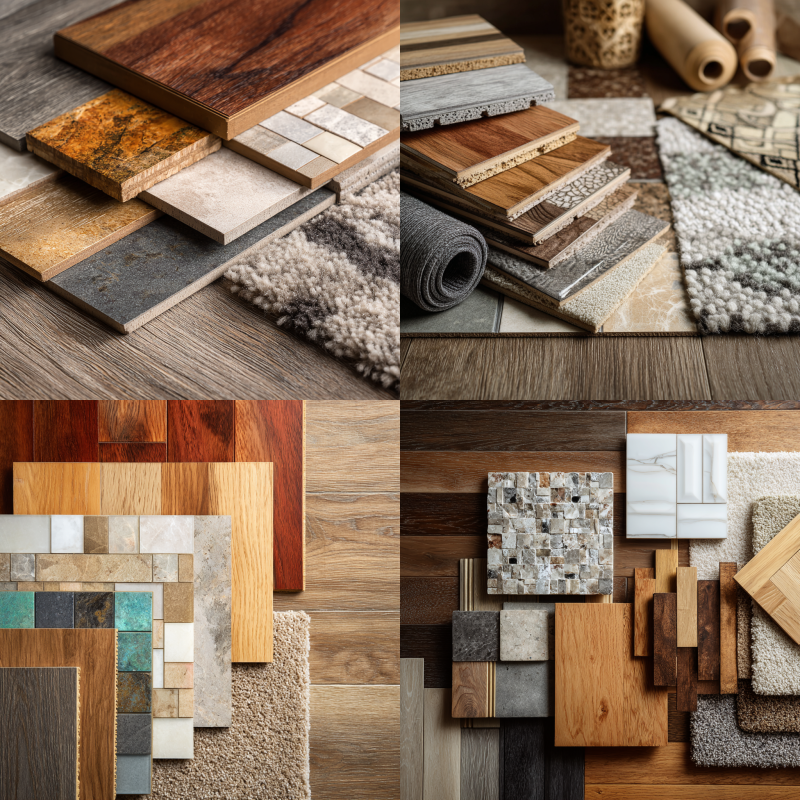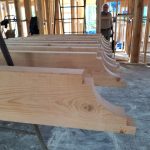
Unlock the Secrets of Types of Flooring Installation Materials
Discover types of flooring installation materials
You might be amazed by how a simple floor upgrade using different types of flooring installation materials can change your home’s look and boost its value. Different materials offer varying levels of durability, cost, and upkeep. The good news, you have more choices today than ever before. Below, we will explore some of the most popular options and how each one might fit your needs. If you want a deeper dive, check out what are the different types of flooring materials for more tips.
Hardwood
Hardwood floors have a track record for lasting 100 years or even longer. According to data from City Floor Supply, well-maintained hardwood can outlive you. Popular species include oak, maple, and walnuts, each adding a distinct color range and grain pattern. The process involves installing solid wood planks among various types of flooring installation materials and typically nailing them onto a wooden subfloor. Once in place, you can sand and refinish them multiple times, which refreshes the surface whenever it starts showing wear. These types of flooring installation materials require proper preparation, and hardwood stands out among types of flooring installation materials for durability.
Pros
- Incredible longevity, often over 100 years
- High resale value
- Can be refinished for a like-new look
Cons
- Higher initial cost (averages $5 to $15 per square foot, plus $3 to $8 per square foot for installation per Sweeten)
- Can be sensitive to humidity and water
If you are curious about the benefits of composite wood floors, you might explore what is engineered hardwood flooring. Engineered hardwood imitates the appearance of solid wood but often costs less.
Engineered Hardwood
Engineered hardwood is a practical twist on solid planks among types of flooring installation materials. Several layers of wood are bonded together under high pressure, topped with a thin layer of genuine hardwood veneer. The result is a floor that looks like real wood but can handle moisture changes better than solid hardwood. Many people appreciate engineered hardwood because it allows you to enjoy the rich character of oak, maple, or walnut without worrying too much about seasonal expansion or contraction. This option stands out among types of flooring installation materials for versatility, making it popular among types of flooring installation materials choices.
Pros
- Resistant to warping from humidity
- Often more affordable than solid hardwood
- Easier to install (click-together or glue-down methods)
Cons
- Cannot be refinished as many times as solid wood
- Quality can vary widely across brands
Laminate
Laminate is constructed from compressed wood byproducts fused with a protective layer among types of flooring installation materials. Typically, laminate flooring lasts between 15 and 25 years, according to City Floor Supply. Good news, this material also resists staining and scratching better than some genuine hardwoods. You might explore what is laminate flooring if you want more detail on how it can mimic stone, tile, or hardwood visuals. This option ranks highly among types of flooring installation materials for affordability, making it appealing among types of flooring installation materials selections.
Pros
- Budget-friendly: $1 to $5 per square foot for materials, plus around $1 to $3 per square foot for installation (per Sweeten)
- Simple DIY-friendly click-lock installation
- Good resistance to spills and scrapes
Cons
- Not as long-lasting as true hardwood
- May feel less “solid” underfoot
Vinyl (Including Luxury Vinyl Tile)
Vinyl flooring has come a long way from thin, rolled sheets among types of flooring installation materials. Today’s Luxury Vinyl Tile (LVT) mimics hardwood, stone, or ceramic, yet it stays waterproof and easy to clean. According to Sweeten, most vinyl flooring costs between $1 to $7 per square foot, plus $1 to $4 in installation. Many homeowners choose vinyl for kitchens, bathrooms, and laundry rooms because it can handle splashes without warping. This option excels among types of flooring installation materials for moisture resistance, positioning it favorably among types of flooring installation materials options.
Pros
- Highly water-resistant
- Affordable and durable (lasts around 10-20 years with proper care)
- Installation methods range from peel-and-stick to glue-down
Cons
- Some find it less upscale than hardwood or porcelain tile
- Lower-end products may show wear faster
Tile
Ceramic and porcelain tiles are prized for their durability among types of flooring installation materials. Porcelain tile, specifically, is dense, low-porosity, and built to handle high traffic. With correct maintenance, porcelain can last decades—or even 75 to 100 years, based on insights constructioncaledonon.com.Tiles require proper underlayment and grouting so they remain secure and crack-free. These types of flooring installation materials excel in wet areas, making them standout types of flooring installation materials for bathrooms. Installation expertise matters significantly with these types of flooring installation materials.
Pros
- Excellent for high-traffic, potentially wet areas
- Easy to clean with neutral detergents
- Wide style variety
Cons
- Installation can get pricey ($1 to $20 per square foot for materials, plus $4 to $10 for labor per Sweeten)
- Requires more time to install and grout
- Cold underfoot unless paired with radiant heating
Carpet
Carpet is that warm, soft feeling under your toes among types of flooring installation materials. Although it averages 5 to 15 years of lifespan, some carpets can last longer if you invest in higher-quality fibers and regular professional cleanings. However, frequent vacuuming is essential to keep dust, hair, and other debris from embedding themselves in the pile. You might see typical pricing hover between $2 to $10 per square foot for materials alone, as noted by Sweeten. This comfort-focused option among types of flooring installation materials requires different maintenance than other types of flooring installation materials, making carpet unique among types of flooring installation materials.
Pros
- Comfortable and quiet, with natural sound insulation
- Often cost-effective to install
- Warm, cozy feel
Cons
- Prone to stains if not cleaned promptly
- Shorter lifespan compared to hardwood or tile
Additional Options (Epoxy, Rubber, Terrazzo)
- Epoxy: Common in garages and commercial areas among types of flooring installation materials. According to Spectra Contract Flooring, epoxy forms a highly durable, chemical-resistant surface. It generally lasts 10-20 years with proper upkeep.
- Rubber: Ideal for gyms or hospitals within types of flooring installation materials. It is cushioned, reduces noise, and prevents impact damage to subfloors, says Spectra Contract Flooring. The drawback is limited aesthetics and possible lingering odor.
- Terrazzo: Beautiful, glossy mix of marble chips and resin or cement among types of flooring installation materials. It can outlast many other floors but tends to be expensive and labor-intensive to install. Large airports often use terrazzo for its near-unbreakable surface within types of flooring installation materials.
Choose your installation method among types of flooring installation materials
Once you pick your material from types of flooring installation materials, the next step is figuring out how to install it. Proper preparation is key, which often includes flooring pre-installation preparation. This might involve addressing squeaky subfloors, ensuring the surface is level, and clearing the room of furniture.
Nail-down or Staple-down
Many solid hardwood floors within types of flooring installation materials require a nail-down approach. You attach each board to the subfloor using nails or staples. This method creates a stable floor with a timeless feel. However, it can be more labor-intensive. If you need more details on how to approach these steps, you might review how to prepare your home for flooring installation to prevent surprises mid-project.
Glue-down
Often used for engineered hardwood, tile, and vinyl among types of flooring installation materials, this method involves spreading adhesive over the subfloor and placing each plank or tile in place. Glue-down can be ideal for minimizing noise, which is especially helpful in multi-story homes. It does take patience. You have to work in small sections so the adhesive doesn’t dry too quickly. If you’re not sure you have the right subfloor conditions, check what is the best way to prepare a subfloor for installation.
Floating Floor
Floating floors “float” above the subfloor without direct attachment within types of flooring installation materials. Laminate and some engineered hardwood planks from types of flooring installation materials use click-lock edges that snap together. A thin underlayment sheet adds cushion and moisture resistance. This method is beginner-friendly among types of flooring installation materials if you have the right tools and follow instructions carefully.
Basic Tools and Prep
Regardless of the method, you’ll need some essentials:
- Measuring tape to calculate exact square footage
- Underlayment (if required by the manufacturer)
- Leveling compound for uneven surfaces
- A saw suited to the chosen flooring material
- Safety gear (gloves, knee pads, and eye protection)
Your best bet is to double-check the recommended process for your specific floor. If you prefer to hire a professional, remember to clarify project timelines, ask about flooring post-installation preparation, and discuss any special conditions like a moisture barrier.
Know cost factors
Flooring costs vary widely depending on the product, labor rates, where you live, and your home’s overall condition. Identifying these factors early helps you set a realistic budget and avoid surprises. A thorough budget also includes preparation expenses—like removing old floors—and the price of baseboards or trim.
Material Costs
- Hardwood: Around $5 to $15 per square foot for materials, plus $3 to $8 for installation, from Sweeten. Exotic woods (teak, mahogany) cost more.
- Laminate: $1 to $5 per square foot, plus $1 to $3 for installation.
- Vinyl: $1 to $7 per square foot, plus $1 to $4 in labor.
- Tile: $1 to $20 per square foot, plus $4 to $10 for installation. Natural stone usually costs the most.
- Carpet: $2 to $10 per square foot, and an extra $1 to $3 for installation.
A reputable contractor can break down these numbers for you. Good news, many suppliers and installers will quote you for free, letting you compare offers.
Installation and Labor
Some materials, like laminate or click-together LVT, are perfect for those who want to DIY. However, tile or nail-down hardwood may be trickier. If you’re wondering what should i do before installing new flooring, it’s wise to factor in time for subfloor repairs and extra materials. Paying for professional service can be a time-saver, but it does raise costs.
Additional Expenses
- Demo and Disposal: Pulling up old floors might cost extra if you can’t do it yourself.
- Subfloor Repair: Squeaks or slopes might need leveling or reinforcement.
- Furniture Storage: You might need an alternate place for your furniture during the project.
Working closely with a flooring contractor can save you from expensive mistakes. They’ll update you on each possible cost, from adhesives to finishing trims. That way, you can plan every detail in advance.
Maintain your new floors
Once your brand-new floors are in place from types of flooring installation materials, focus on the right cleaning tools and a consistent upkeep schedule. According to FLOOR360, the best care strategy depends on your material among types of flooring installation materials. Frequent dust mopping or vacuuming keeps grit at bay, and protective pads under furniture help prevent scratches across all types of flooring installation materials.
Hardwood Care
Dust and dirt act like sandpaper on hardwood. Quick daily sweeps with a soft cloth or microfiber broom will keep your floor shining. Place entry mats at your doors, and use rugs in high-traffic spots. If you want a detailed guide on preserving that fresh finish, see how to maintain new hardwood floors after installation.
- Avoid soaking wood floors with water, which can warp the planks
- Always wipe up spills promptly
- Refinish floors whenever the surface starts losing luster
Carpet Upkeep
Carpet needs regular vacuuming to lift dust and keep fibers fluffy. Professional steam cleaning is often advised every 12 to 18 months to remove stubborn dirt. If you spill something, blot it quickly—don’t rub. Keeping children and pets from tracking mud inside is another simple way to protect that plush surface.
Tile Maintenance
Stay on top of tile cleaning with a mild detergent or neutral floor cleaner. Rinse well to avoid film build-up. Consider sealing grout lines annually, as it helps block stains and mildew. If your tile is chipped or a piece breaks, replace it as soon as possible to prevent subfloor damage underneath.
Laminate and Vinyl Best Practices
A gentle approach is ideal. Sweep or vacuum to remove sand or debris, followed by a damp mop. Both laminate and vinyl handle everyday foot traffic well, but abrasive cleaners or excessive water can harm the finish. Some experts advise using specialized solutions with a microfiber mop for a streak-free shine. If you’re cleaning right after an installation, you can read how to clean floors after installation for step-by-step guidance.
Post-Installation Tips
- Wait before walking: Material guidelines vary. You may want to see how long before you can walk on newly installed flooring.
- Use felt pads or floor protectors under chairs and tables to reduce scuff marks.
- Quickly wipe away liquids to prevent swelling, bubbling, or staining.
Types of flooring installation materials
You now have a clearer understanding of different flooring materials—plus how to install, budget for, and maintain them. Whether you lean toward the timeless elegance of hardwood, the budget-friendly convenience of laminate, or the water resistance of tile or vinyl, there is a floor out there that fits your style. Each type offers its own pros and cons, so trust your instincts when picking a material and focus on proper installation. By taking these steps, you will enjoy floors that look fantastic for years to come.
Ready to Transform Your Floors with the Right Materials?
Choosing the best flooring doesn’t have to feel overwhelming or complicated. Whether you’re leaning toward timeless hardwood, durable vinyl, elegant tile, or budget-friendly laminate, a bit of research and the right preparation can make all the difference. With so many beautiful and practical options available, finding the perfect fit for your home is easier than you think.
Frequently Asked Questions
- What are the different types of flooring materials?
There are several popular types of flooring installation materials, including hardwood, laminate, vinyl, tile, and carpet. Each offers unique benefits—hardwood adds natural beauty, laminate is cost-effective and DIY-friendly, while vinyl and tile are durable and water-resistant. Learn more about your options on our Flooring Sales and Installation page.
2. What is engineered hardwood flooring?
Engineered hardwood flooring is made of a real hardwood veneer layered over a plywood or fiberboard core. It provides the beauty of solid wood while offering better resistance to moisture and temperature changes. This makes it a great choice for basements and humid areas.
3. What is laminate flooring?
Laminate flooring is a multi-layer synthetic product designed to mimic the appearance of wood, stone, or tile. It features a photographic surface layer, a durable wear layer, and a core made from high-density fiberboard. Laminate is popular for its affordability, ease of installation, and low maintenance.
d materials make all the difference. Visit our Flooring Sales and Installation page to explore your options or learn how to prepare your home for flooring installation the right way.
Don’t just install—install smart. Your dream floor starts with the right foundation.
4. How often should I clean my floors to maintain quality?
A quick sweep or vacuum every few days keeps grit away. Deeper cleaning varies by material. Carpets often need professional steam-cleaning annually or biannually, while hardwood or tile can do well with a damp mop weekly.
5. Is moisture a big concern for laminate and hardwood floors?
Yes. Both can expand or warp if exposed to excess water. Address any spills quickly, and control indoor humidity levels to protect your floors.
6. Should I invest in expensive underlayment?
A quality underlayment can reduce noise and help with moisture. Whether it is worth the extra cost depends on your material choice and local climate.
7. Will under-floor heating damage my floors?
Many modern materials, including some engineered wood and tile, are compatible with radiant heat systems. Follow the manufacturer’s temperature guidelines to avoid damage.
Key takeaway
- Prep is everything. Evaluate your subfloor, measure accurately, and plan a budget that covers extra costs.
- Choose materials based on your traffic levels. Hardwood or tile can handle busy spaces, while carpet works best in cozy, low-traffic areas.
- Installation methods should match the floor type and your skill level. Floating or click-lock floors are generally simpler for first-timers.
- Proper cleaning extends floor life. Sweep or vacuum regularly, and use cleaning agents suited to your specific material.
- Protect your investment. Use felt pads or rugs in high-wear areas, tackle spills quickly, and refinish or reseal when needed.




